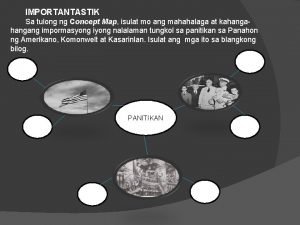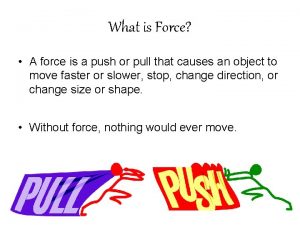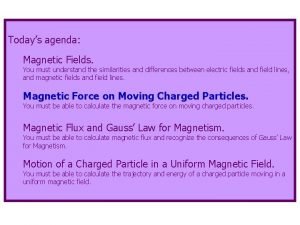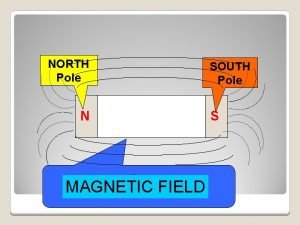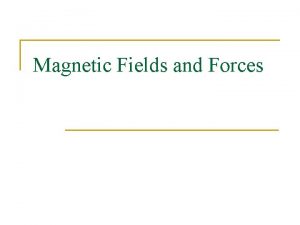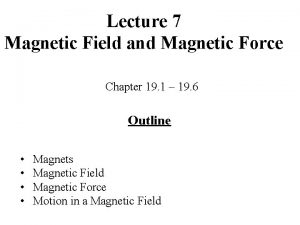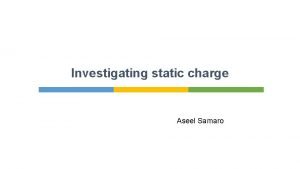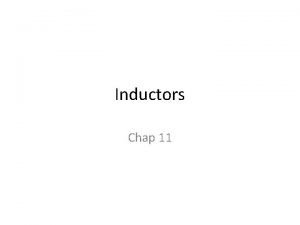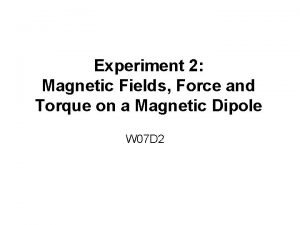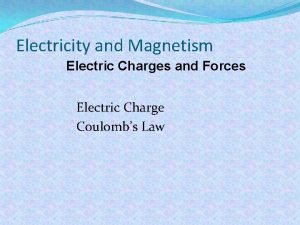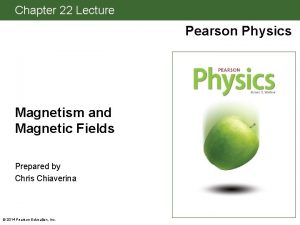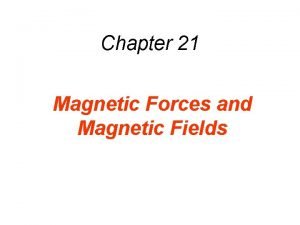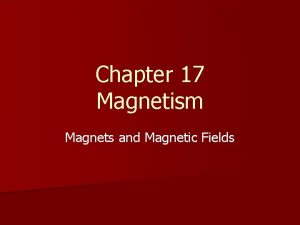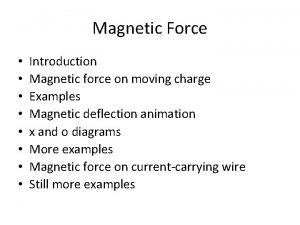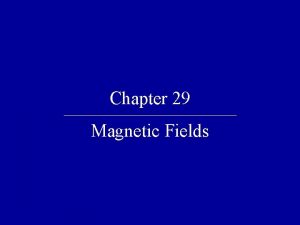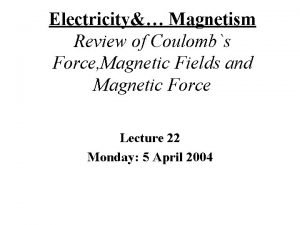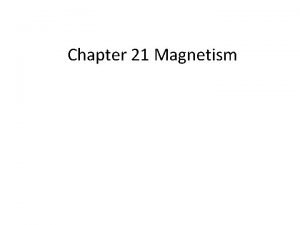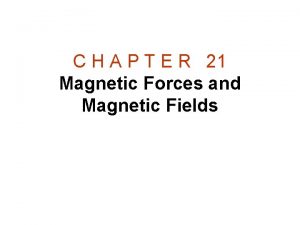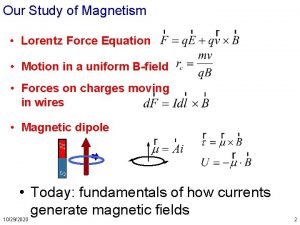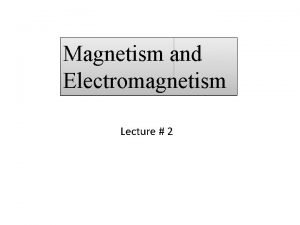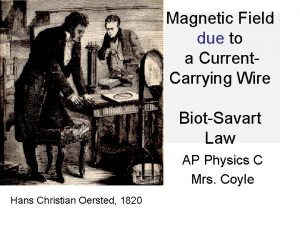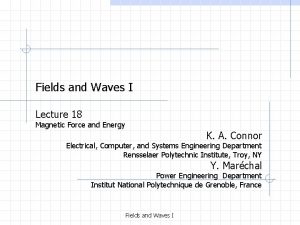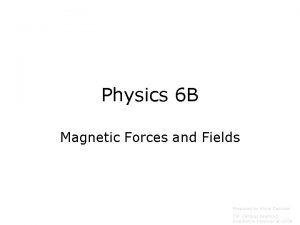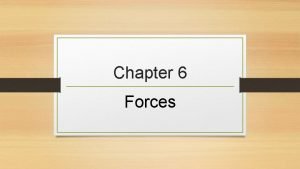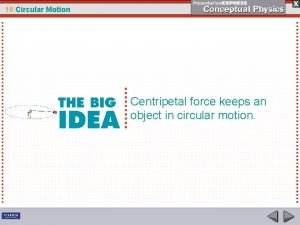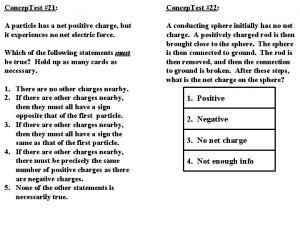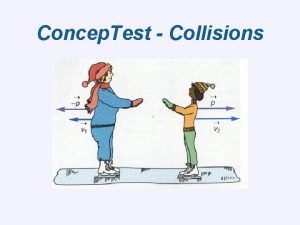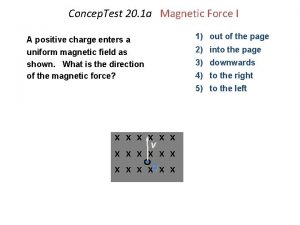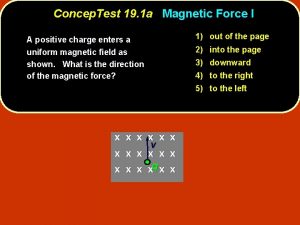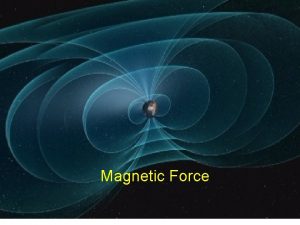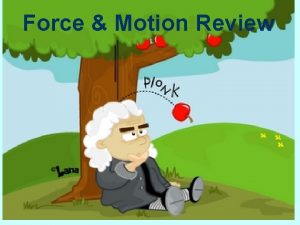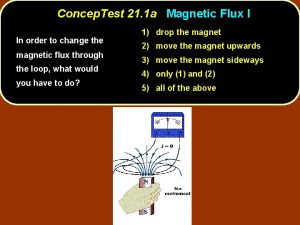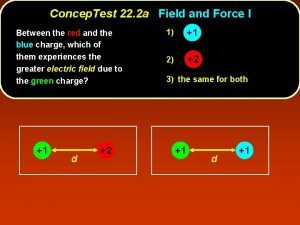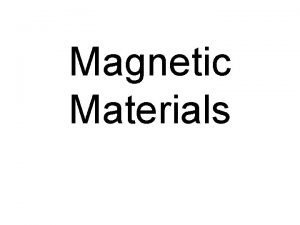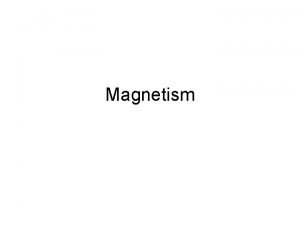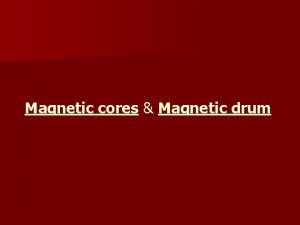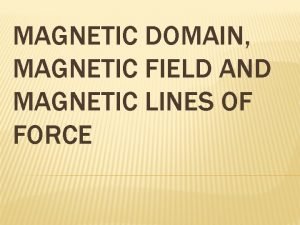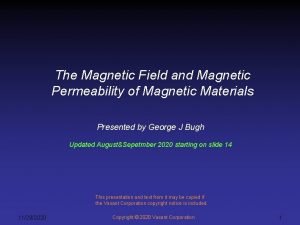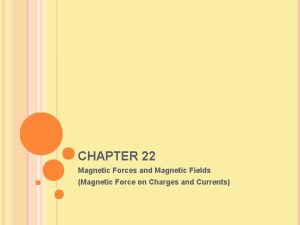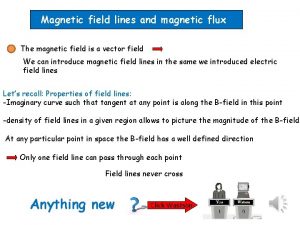Concep Test 20 1 a Magnetic Force I


































- Slides: 34

Concep. Test 20. 1 a Magnetic Force I 1) out of the page A positive charge enters a uniform magnetic field as shown. What is the direction of the magnetic force? 2) into the page 3) downwards 4) to the right 5) to the left x x x v x x x x xq x x

Concep. Test 20. 1 a Magnetic Force I A positive charge enters a uniform magnetic field as shown. What is the direction of the magnetic force? 1) out of the page 2) into the page 3) downwards 4) to the right 5) to the left Using the right-hand rule, you can see that the magnetic force is directed to the left Remember that the magnetic force must be perpendicular to BOTH the B field and the velocity x x x v x x x x. Fx xq x x

Concep. Test 20. 1 b Magnetic Force II A positive charge enters a uniform magnetic field as shown. What is the direction of the magnetic force? 1) out of the page 2) into the page 3) downwards 4) upwards 5) to the left x x x x x vx x q x x x

Concep. Test 20. 1 b Magnetic Force II A positive charge enters a uniform magnetic field as shown. What is the direction of the magnetic force? 1) out of the page 2) into the page 3) downwards 4) upwards 5) to the left Using the right-hand rule, you can see that the magnetic force is directed upwards Remember that the magnetic force must be perpendicular to BOTH the B field and the velocity x x x F x x vx x q x x x

Concep. Test 20. 1 c Magnetic Force III A positive charge enters a uniform magnetic field as shown. What is the direction of the magnetic force? 1) out of the page 2) into the page 3) zero 4) to the right 5) to the left ®®®®® ® ® ®v® ® ®®®®® q ®®®®®

Concep. Test 20. 1 c Magnetic Force III A positive charge enters a uniform magnetic field as shown. What is the direction of the magnetic force? 1) out of the page 2) into the page 3) zero 4) to the right 5) to the left Using the right-hand rule, you can see that the magnetic force is ®®®®® directed into the page Remember ® ® ®v® ® that the magnetic force must be ®®®®® ´ q F ®®®®® perpendicular to BOTH the B field and the velocity

Concep. Test 20. 2 Atomic Beams • A beam of atoms enters a magnetic field region. What path will the atoms follow? x x x x x 1 x x x x x x x 2 x x x x x x 4 x x x 3

Concep. Test 20. 2 Atomic Beams • A beam of atoms enters a magnetic field region. What path will the atoms follow? x x x x x 1 x x x x x x x 2 x x x x x x 4 3 x x x Atoms are neutral objects whose net charge is zero Thus they do not experience a magnetic force. Follow-up: What charge would follow path #3? What about path #1?

Concep. Test 20. 3 Magnetic Field • A proton beam enters into a magnetic field region as shown below. What is the direction of the magnetic field B? 1) + y 2) – y 3) + x 4) + z (out of page) 5) – z (into page) y x

Concep. Test 20. 3 Magnetic Field • A proton beam enters into a magnetic field region as shown below. What is the direction of the magnetic field B? 1) + y 2) – y 3) + x 4) + z (out of page) 5) – z (into page) The picture shows the force acting in the +y direction Applying the y right-hand rule leads to a B field that points into the page The B field must be out of the plane because B v and B F. F Follow-up: What would happen to a beam of atoms? x

Concep. Test 20. 4 a Mass Spectrometer I x x x • Two particles of the same mass enter a magnetic field with the same speed and follow the paths shown. Which particle has the bigger charge? x x x x x x x x x x x x x x x 3) both charges are equal 1 2 4) impossible to tell from the picture

Concep. Test 20. 4 a Mass Spectrometer I x x x • Two particles of the same mass enter a magnetic field with the same speed and follow the paths shown. Which particle has the bigger charge? x x x x x x x x x x x x x x x 3) both charges are equal 1 2 4) impossible to tell from the picture The relevant equation for us is: According to this equation, the bigger the charge, the smaller the radius. Follow-up: What is the sign of the charges in the picture?

Concep. Test 20. 4 b Mass Spectrometer II A proton enters a uniform magnetic field that is perpendicular to the proton’s velocity. What happens to the kinetic energy of the proton? 1) it increases 2) it decreases 3) it stays the same 4) depends on the velocity direction 5) depends on the B field direction x x x x x x x x x x x x x x x

Concep. Test 20. 4 b Mass Spectrometer II A proton enters a uniform magnetic field that is perpendicular to the proton’s velocity. What happens to the kinetic energy of the proton? The velocity of the proton changes direction but the magnitude (speed) doesn’t change. Thus the kinetic energy stays the same 1) it increases 2) it decreases 3) it stays the same 4) depends on the velocity direction 5) depends on the B field direction x x x x x x x x x x x x x x x

Concep. Test 20. 5 Velocity Selector 1) up (parallel to E ) What direction would a B field have to point for a beam of electrons moving to the right to go undeflected through a region where there is a uniform electric field pointing vertically upward? 2) down (antiparallel to E ) 3) into the page 4) out of the page 5) impossible to accomplish E B=? electrons v

Concep. Test 20. 5 Velocity Selector What direction would a B field have to point for a beam of electrons moving to the right to go undeflected through a region where there is a uniform electric field pointing vertically upward? Without a B field, the electrons feel an electric force downwards In order to compensate, the magnetic force has to point upwards Using the right-hand rule and the fact that the electrons are negatively charged leads to a B field pointing out of the page 1) up (parallel to E ) 2) down (antiparallel to E ) 3) into the page 4) out of the page 5) impossible to accomplish E B=? electrons v

Concep. Test 20. 6 a Magnetic Force on a Wire I • A horizontal wire carries a current and is in a vertical magnetic field. What is the direction of the force on the wire? 1) left 2) right 3) zero 4) into the page 5) out of the page I B

Concep. Test 20. 6 a Magnetic Force on a Wire I • A horizontal wire carries a current and is in a vertical magnetic field. What is the direction of the force on the wire? 1) left 2) right 3) zero 4) into the page 5) out of the page Using the right-hand rule, we see that the magnetic force must point out of the page Since F must be perpendicular to both I and B, you should realize that F cannot be in the plane of the page at all I B

Concep. Test 20. 6 b Magnetic Force on a Wire II • 1) left A horizontal wire carries a current and is in a vertical magnetic field. What is the direction of the force on the wire? 2) right 3) zero 4) into the page 5) out of the page I B

Concep. Test 20. 6 b Magnetic Force on a Wire II • A horizontal wire carries a current and 1) left is in a vertical magnetic field. What is the 2) right direction of the force on the wire? 3) zero 4) into the page 5) out of the page I When the current is parallel to the magnetic field lines, the force on the wire is zero B

Concep. Test 20. 7 a Magnetic Force on a Loop I • 1) + x A rectangular current loop is in a uniform magnetic field. What is the direction of the net force on the loop? 2) + y 3) zero 4) - x 5) - y B z y x

Concep. Test 20. 7 a Magnetic Force on a Loop I • A rectangular current loop is in a uniform magnetic field. What is the direction of the net force on the loop? 1) + x 2) + y 3) zero 4) - x 5) - y Using the right-hand rule, we find that each of the four wire segments will experience a force outwards from the center of the loop. Thus, the forces of the opposing segments cancel, so B z the net force is zero y x

Concep. Test 20. 7 b Magnetic Force on a Loop II • If there is a current in the loop in the direction shown, the loop will: 1) move up 2) move down 3) rotate clockwise 4) rotate counterclockwise 5) both rotate and move B field out of North B field into South S N N S

Concep. Test 20. 7 b Magnetic Force on a Loop II • If there is a current in the loop in the direction shown, the loop will: 1) move up 2) move down 3) rotate clockwise 4) rotate counterclockwise 5) both rotate and move Look at the North Pole: here the F magnetic field points to the right and the current points out of the page The N S right-hand rule says that the force must point up. up At the south pole, the same logic leads to a downward force. Thus the loop rotates clockwise F

Concep. Test 20. 8 a Magnetic Field of a Wire I • 1) direction 1 If the currents in these wires have the same magnitude, but opposite directions, what is the direction of the magnetic field at point P? 2) direction 2 3) direction 3 4) direction 4 5) the B field is zero 1 P 4 2 3

Concep. Test 20. 8 a Magnetic Field of a Wire I • If the currents in these wires have the same magnitude, but opposite directions, what is the direction of the magnetic field at point P? 1) direction 1 2) direction 2 3) direction 3 4) direction 4 5) the B field is zero 1 P Using the right-hand rule, we can sketch the B fields due to the two currents. Adding them up as vectors gives a total magnetic field pointing downward 4 2 3

Concep. Test 20. 8 b Magnetic Field of a Wire II – Each of the wires in the figures below carry the same current, either into or out of the page. In which case is the magnetic field at the center of the square greatest? 1 B=? 2 B=? 1) arrangement 1 2) arrangement 2 3) arrangement 3 4) same for all 3 B=?

Concep. Test 20. 8 b Magnetic Field of a Wire II – Each of the wires in the figures below carry the same current, either into or out of the page. In which case is the magnetic field at the center of the square greatest? 1 2 1) arrangement 1 2) arrangement 2 3) arrangement 3 4) same for all 3

Concep. Test 20. 9 a Field and Force I • 1) + z (out of page) A positive charge moves parallel to a wire. If a current is suddenly turned on, which direction will the force act? 2) - z (into page) 3) + x 4) - x 5) - y y +q x z I

Concep. Test 20. 9 a Field and Force I • A positive charge moves parallel to a wire. If a current is suddenly turned on, which direction will the force act? 1) + z (out of page) 2) - z (into page) 3) + x 4) - x 5) - y Using the right-hand rule to determine the magnetic field produced by the wire, we find that at the position of the charge +q (to the left of the wire) the B field points out of the page Applying the right-hand rule again for the magnetic force on the charge, we find that +q experiences a force in the +x direction y +q x z I

Concep. Test 20. 9 b Field and Force II • Two straight wires run parallel to each other, each carrying a current in the direction shown below. The two wires experience a force in which direction? 1) toward each other 2) away from each other 3) there is no force

Concep. Test 20. 9 b Field and Force II • Two straight wires run parallel to each other, each carrying a current in the direction shown below. The two wires experience a force in which direction? 1) toward each other 2) away from each other 3) there is no force The current in each wire produces a magnetic field that is felt by the current of the other wire. Using the right-hand rule, we find that each wire experiences a force toward the other wire (i. e. , an attractive force) force when the currents are parallel (as shown). Follow-up: What happens when one of the currents is turned off?

Concep. Test 20. 10 Current Loop • 1) left What is the direction of the magnetic field at the center (point P) of the square loop of current? 2) right 3) zero 4) into the page 5) out of the page I P

Concep. Test 20. 10 Current Loop • What is the direction of the magnetic field at the center (point P) of the square loop of current? Use the right-hand rule for each wire segment to find that each segment has its B field pointing out of the page at point P. 1) left 2) right 3) zero 4) into the page 5) out of the page I P
 Gawain 2 concept mapping
Gawain 2 concept mapping Magnetic field and magnetic force
Magnetic field and magnetic force Confidential
Confidential Flux density unit
Flux density unit Magnetic moment and magnetic field relation
Magnetic moment and magnetic field relation Magnetic force push or pull
Magnetic force push or pull 21lwuy8i6hw -site:youtube.com
21lwuy8i6hw -site:youtube.com 21lwuy8i6hw -site:youtube.com
21lwuy8i6hw -site:youtube.com Magnetic field strength
Magnetic field strength Force of magnetic field
Force of magnetic field About magnets
About magnets Unit of magnetic force
Unit of magnetic force Does magnetic field exerts force on a static charge
Does magnetic field exerts force on a static charge Inductance formula
Inductance formula Magnetic dipole force
Magnetic dipole force Does magnetic field exerts force on a static charge
Does magnetic field exerts force on a static charge Magnetic force microscopy data recovery
Magnetic force microscopy data recovery Visualizing magnetic field
Visualizing magnetic field Does magnetic field exerts force on a static charge
Does magnetic field exerts force on a static charge Force exerted by magnets
Force exerted by magnets Example of magnetic force
Example of magnetic force Magnetic force quiz
Magnetic force quiz Force of unit
Force of unit A magnetic force
A magnetic force A magnetic force
A magnetic force Units of magnetic field
Units of magnetic field Lorentz force calculator
Lorentz force calculator Relative permeability of magnetic material
Relative permeability of magnetic material Magnetic field due to a curved wire segment
Magnetic field due to a curved wire segment What is magnetic force
What is magnetic force Magnetic force
Magnetic force Non-contact forces portfolio
Non-contact forces portfolio Vt=2pir/t
Vt=2pir/t Long range force
Long range force If you whirl a tin can on the end of a string
If you whirl a tin can on the end of a string
